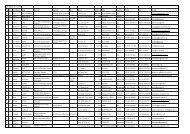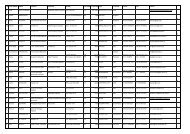icvg 2009 part I pp 1-131.pdf - Cornell University
icvg 2009 part I pp 1-131.pdf - Cornell University
icvg 2009 part I pp 1-131.pdf - Cornell University
Create successful ePaper yourself
Turn your PDF publications into a flip-book with our unique Google optimized e-Paper software.
— 33 —<br />
RESULTS AND DISCUSSION<br />
Our a<strong>pp</strong>roach of combining random-primer generated<br />
cDNAs and degenerate-primer RT-PCR allowed<br />
identification of dozens of viruses in tested native Vitis<br />
specimens to date. The majority of these viruses are as yet<br />
unreported plant virus species with ssRNA or dsRNA<br />
genomes. Viruses detected in Vitis s<strong>pp</strong>. of the southeastern<br />
United States so far are briefly commented on below.<br />
Genus Potyvirus. Multiple overla<strong>pp</strong>ing clones<br />
containing potyvirus-like sequences were generated from a<br />
muscadine specimen collected from Southern Mississi<strong>pp</strong>i.<br />
A contig counting almost 1,500 nt was translated and<br />
compared with viral sequences available in NCBI. Results<br />
showed that clones belonged to an isolate of Bean common<br />
mosaic virus (BCMV). Curiously, the “muscadine isolate”<br />
shared 99% amino acid identity with the “peanut stripe”<br />
strain of BCMV (previously known as Peanut stripe mosaic<br />
virus) and less (93%) with the other isolates of the same<br />
virus. Considering that BCMV is one of the most<br />
widespread viruses in peanut fields in Mississi<strong>pp</strong>i (S.<br />
Sabanadzovic and D. Ingram, unpublished data) and that<br />
the majority of peanut production is located in the Southern<br />
<strong>part</strong> of the state, it is likely that this virus was transmitted<br />
from neighboring peanut plantations.<br />
Genus Marafivirus. A new marafivirus, denominated<br />
Grapevine virus Q and characterized by unique<br />
organization of the palm sub-domain of RNA-dependent<br />
RNA polymerase was detected in multiple samples of<br />
muscadines in Mississi<strong>pp</strong>i, as well as in summer grapes and<br />
Vitis vinifera (for more extensive explanations about this<br />
phenomenon see Sabanadzovic et al., <strong>2009</strong>a and<br />
Sabanadzovic et al., <strong>2009</strong>b). Surprisingly, the same virus<br />
was found in wild Rubus s<strong>pp</strong>. making it the first tymovirid<br />
capable of infecting blackberries and grapevines. The<br />
genome of the muscadine isolate of this virus was<br />
completely sequenced at Mississi<strong>pp</strong>i State <strong>University</strong> as<br />
well as several additional isolates including the one from<br />
wild blackberry. The same virus was characterized by<br />
a<strong>pp</strong>lication of new generation of sequencing methodologies<br />
at the <strong>University</strong> of California and reported under the name<br />
Grapevine Syrah virus 1 (Al Rwahnih et al., <strong>2009</strong>).<br />
Genus Oryzavirus. Cloning of a reverse-transcribed<br />
complex dsRNA pattern recovered from petioles of a<br />
summer grape specimen collected in a natural ecosystem<br />
(GSMNP) generated a library of clones with sequences<br />
reminiscent of reoviruses. Analyses of extensive nucleotide<br />
sequence data generated for multiple viral segments<br />
revealed the presence of a new viral species in the genus<br />
Oryzavirus. The highest identities (a<strong>pp</strong>rox. 40%) between<br />
this virus and Rice ragged stunt virus (RRSV), the type<br />
species of the genus, were observed in viral segment 4<br />
encoding a putative polymerase. Interestingly, this is only<br />
the second virus species described in this genus. To our<br />
knowledge, oryzaviruses were limited to rice in<br />
Southeastern Asia. Our work, together with a report of<br />
association of an oryzavirus with crumbly fruit disease of<br />
red raspberry in the Pacific Northwest (Quito et al., <strong>2009</strong>)<br />
gives new insights into the host range and geographical<br />
distribution of this type of viruses. The exchange of initial<br />
sequence data between the two research groups revealed<br />
high amino acid identity levels (80-85%) between<br />
oryzaviruses from summer grape and raspberry indicating<br />
that they may represent distinct isolates of the same, novel<br />
species in the genus Oryzavirus.<br />
Genus Enamovirus (family Luteoviridae). Analyses of<br />
sequence data originally generated from a specimen of wild<br />
summer grape (Vitis aestivalis) collected from Great Smoky<br />
Mountains National Park indicated the presence of a new<br />
member of the family Luteoviridae. Molecular data<br />
revealed the presence of five open reading frames, an<br />
organization resembling that of Pea enation mosaic virus 1<br />
(PEMV-1), the type species and currently sole member of<br />
the genus Enamovirus in the family Luteoviridae. Virus<br />
from summer grape shared ca 55% and 44% identical<br />
amino acids in RNA-dependent RNA polymerase and coat<br />
protein cistrons. Phylogenetic analyses confirmed<br />
allocation of this virus in the genus Enamovirus. Virusspecific<br />
primers designed on viral coat protein allowed<br />
detection of this virus in a few additional Vitis specimens.<br />
“PEMV disease complex” is caused by an intimate and<br />
symbiotic relationship of two taxonomically unrelated<br />
viruses: PEMV-1 (gen. Enamovirus) and PEMV-2 (gen.<br />
Umbravirus). We are currently investigating the possible<br />
association of an umbravirus with the enamovirus from<br />
summer grape, although random primer cloning did not<br />
give any evidence for that.<br />
Genus Endornavirus. The presence of high molecular<br />
weight dsRNAs in several samples was ascertained to be<br />
due to endornaviruses. Amplicons of expected size were<br />
consistently generated in RT-PCR tests from dsRNApositive<br />
specimens using endornavirus-specific degenerate<br />
primers (Sabanadzovic & Valverde, <strong>2009</strong>). Pairwise<br />
comparisons of generated clones showed that at least two<br />
distinct endornaviruses, with sequences differing as much<br />
as 40%, have been identified so far in autochthonous Vitis<br />
germplasm.<br />
Family Partitiviridae. Numerous clones with<br />
significant sequence similarities to known cryptoviruses<br />
were observed and analyzed during this study. In <strong>part</strong>icular,<br />
a cryptic virus with sequence homologies with Raphanus<br />
sativus cryptic virus 3 and a putative cryptovirus similar to<br />
Beet cryptic virus 3 were both detected in muscadine<br />
samples.<br />
Unclassified dsRNA viruses. Curiously, a pool of<br />
clones generated from summer grape samples from<br />
GSMNP contained sequences similar (50%) to both<br />
genomic segments of the recently described Curvularia<br />
thermal tolerance virus (CThTV; Márquez et al., 2007), a<br />
virus that infects an endophytic fungus, Curvularia<br />
protuberata, and confers heat tolerance to the plant host<br />
and enables it to survive in some extreme environments<br />
such as the hot soils of the Yellowstone National Park. At<br />
this point we focus on the identification of the fungal host<br />
of this virus and plan to go beyond simple virus description.<br />
Clones with sequences related to another recently<br />
described and unclassified dsRNA virus, Southern tomato<br />
virus (STV; Sabanadzovic et al., <strong>2009</strong>) were obtained from<br />
summer grapes. Curiously, similar sequences were found in<br />
multiple rhododendron and viburnum samples indicating<br />
that this type of virus is rather widespread in nature.<br />
Mycoviruses. A significant number of analyzed clones<br />
had significant identities with a range of mycoviruses (i.e.<br />
Progrès Agricole et Viticole, <strong>2009</strong>, Hors Série – Extended abstracts 16 th Meeting of ICVG, Dijon, France, 31 Aug – 4 Sept <strong>2009</strong>




